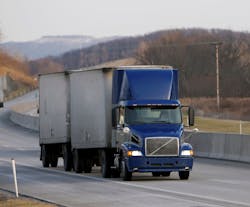It’s time for an 'adult conversation' on longer, heavier trucks
SAN ANTONIO. One of the biggest hot-button issues in the trucking industry in recent years has been efforts to move legislation through Congress that would authorize longer and/or heavier trucks.
Groups such as the American Trucking Assns. (ATA) and the U.S. Chamber of Commerce among others have pushed the efforts forward. Generally, the proposals feature 33-ft. twin trailers or 96,000 lb. trailers equipped with three axles to maintain weight balance. Those proposals have not found enough traction yet to pass, though.
Despite some evidence that suggest 33-ft. trailers are no more dangerous than current 28-ft. models, or that properly equipped 96,000 lb. trailers do no more damage to roads, opponents have managed to stop these efforts.
In 2015, when the Dept. of Transportation shut down the possibility of a program, DOT Under Secretary Peter Rogoff wrote in a letter that “at this time, the department believes that the current data limitations are so profound that the results cannot accurately be extrapolated to predict national impacts. As such, DOT believes that no changes in the relevant truck size and weight laws and regulations should be considered until these data limitations are overcome.”
DOT said much the same thing in April of this year when it formally rejected efforts to expand truck size and weights.
To Bill Graves, former president and CEO of ATA, the logic doesn’t follow. Speaking at the Meritor and Pressure Systems International 2016 Annual Fleet Technology Event in San Antonio this week, Graves said that Congress needs to address the freight productivity of tractor-trailers, and it starts with size and weight.
Related: DOT releases truck size and weight study
“I don’t see how we can keep up with demands [of a growing economy] … and keep pulling the same weight,” he said. “The fact that we can’t have an adult conversation about it in Congress is a problem. We need to address truck productivity.”
Rick Mihelic, program manager of the North America Council for Freight Efficiency, echoed Graves’ statements. Mihelic noted that freight demand continues to increase and density per truck (how much freight is loaded into a trailer) continues to increase yet due to many factors, including hours-of-service, the number of miles driven per truck has declined for the past 15 years.
“This is where the discussion has to start,” he said. “How do you solve that? Either you get more drivers or you give each truck the ability to haul more freight.”
The Coalition for Transportation Productivity (CTP), a group of nearly 200 of the nation’s manufacturers, shippers, carriers and allied associations, has been pushing Congress for action on the issue for several years.
In a letter and accompanying one-page brief to Congress from CTP Executive Director John Runyan, the organization cited U.S. DOT technical findings that six-axle trucks weighing either 91,000 or 97,000 lbs. maintain key braking and handling characteristics, allowing them to safely ship more freight and reduce vehicle miles traveled, logistics and pavement costs, and environmental impacts. The technical report also finds that the use of these vehicles would lead to a minimal diversion of freight from rail to truck, which would be more than offset by projected freight rail growth.
“The actual study data provides strong support for allowing trucks equipped with six axles to carry more freight on Interstate System highways,” Runyan wrote. “This is the real message for Congress, despite the fact that U.S. DOT political leadership, after three years of study and 1,100 pages of released data, wrote a cover letter citing insufficient information and recommending against any changes in truck size and weight regulations. While the Administration could not find a political path to support truck weight reform, we urge members of Congress to review the study findings for themselves and allow carefully crafted reforms in vehicle weight regulation to move forward.”
Others, though, including safety groups and the Teamsters, have fought the idea.
"The claim that fewer trucks will be an end-product of truck size and weight increases simply isn't true," Jim Hoffa, Teamsters general president, has said in the past. "This is about safety and ensuring as safe a workplace for our driver members on the highways as anyone working on a factory floor."
Albeit a small sample size, but in early 2015, a Maine state official attributed a drop in highway fatalities in part to a federal pilot program that was allowing heavier tractor-trailers with six axles rated up to 100,000-lbs. GCW on all interstate highways in Maine.
“Commercial vehicle related fatalities dropped in 2014 to 10 fatalities compared to 18 in 2013,” James Tanner, fatal accident system analyst for the Maine Bureau of Highway Safety, said in a Bangor Daily News story. “Maine averaged 16.2 commercial vehicle related crash fatalities from 2009 to 2013. Overall, Maine has experienced a decrease in the number of commercial vehicle related fatalities from 2009 when we experienced 23 commercial vehicle related fatalities.”
